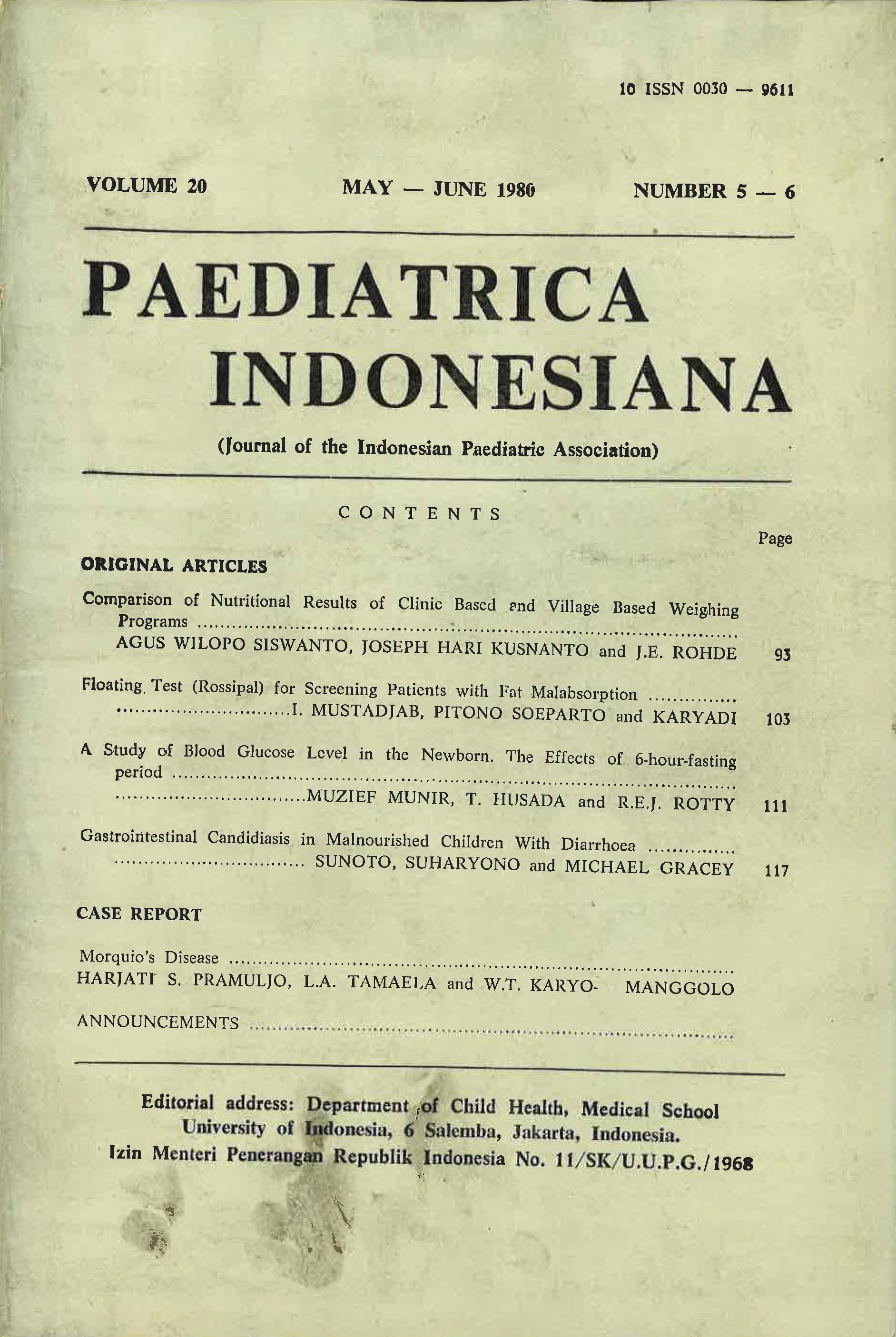Gastrointestinal Candidiasis in Malnourished Children with Diarrhoea
DOI:
https://doi.org/10.14238/pi20.5-6.1980.117-29Keywords:
candidiasis, candida, gastrointestinal candidiasis, malnourishedAbstract
It is known that the frequency of intestinal Candidiasis in infants and children below 3 years of age is very high, particularly in malnourished children. It has been shown also that Candida can reduce the absorption of sugar, water and electrolytes (Burke et al., I977; Thelen et al., I978).
Recently we have studied the frequency of gastrointestinal Candidiasis and the Candida-killing-ability of leucocytes in Indonesian children.
Species of Candida were found significantly more often in throat swabs, gastric, small intestinal contents and stools of malnourished children in comparison with specimens of reasonably well-nourished children.
Furthermore there were marked qualitative differences in the species found in these groups according to their nutritional status.
Studying the Candidacidal activity of leucocytes it shows that in malnourished children the killing-ability is significantly lower than in well-nourished children. These findings suggest that gastrointestinal Candidiasis may contribute to the pathogenesis of diarrhoea in malnourished children.
References
2. BURKE, V.; HOUGHTON, M. and GRACEY, M. : Ef,fect of enteric microorganisms on intestinal sugar and fatty acid absorption. Aus. J. Exp. Bioi. Med. Sci. 55 : 423 (1977) .
3. CHANDRA, R.K. : Immunocompetence in undernutrition. J. Paediatr. 81 : 1194 -1200 (1972).
4. DRASAR, R.S.; SHINER, M. and MCLEOD, G.M. : The bacterial flora of the gastrointestinal tract in healthy and achlorhydric persons. Gastroenterol . 5,6 : 71 (1969).
5. EDITORIAL LANCET : Classification of Infantile malnutrition. Lancet ii : 302 (1970).
6. FERGUSON, A.C.; LAWLOR, G.J,; NEUMANN, C.G.; OH, W. and STEIHM, E.R. : Decrease rosetteforming
lympbocyte in malnutrition and intrauterine growth retardation. J. Pediatr. 85 : 717 (1974).
7. GEEFHUYSEN, J.; ROSEN, E.V.; KATZ, J.; IPP, T . and METZ, J.: Impaired cellular immunity in Kwashiorkor with improvement after- thetapy. Br. Med. J. 4 : 527 (1971) .
8. GRACEY, M.; STONE, D.E.; SUHARYONO and SUNOTO- : Oropharyngeal microflora in malnourished children. Aust. Paediatr. J. 9 : 260 (1973).
9. GRACEY, M.; SUHARYONO and SUNOTO : Use of a simple duodenal capsule to study upper intestinal microflora. Arch. Dis. Childh. 52 : 74 (1977).
10. GRACEY, M.; SUHARYONO.; SUNOTO and STONE D.E. : Microbial Contamination of the gut: another feature of malnutrition. Am. J. Clin. Nutr. 26: 1170 (1973).
11. KOZINN, P.J. and TASCHDJIAN C.L.: Enteric Candidiasis, diagnosis imd clinical consideration. Pediatr. 30: 71 (1962).
12. LEHRER, R.J. and CLINE, M.J.: Interaction of Candida albicans with human leucocytes and serum. J. Bacterial. 98 : 996 (1969).
13. MATA, L.J.; JIMENEZ, F.; GORDON, M.; ROSALES, R.; PRERA, E.; SCHNEIDER, R.E. and VITERI, F.: Gastrointestinal flora of children with protein calorie malnutrition. Am. J. clin. Nutr. 25 : 1118 - 1126 (1972).
14. ONO DEWANOTO, ALISJAHBANA, A.; SURATMAN, E. and SUGIRI: Diarrhea in children between the Age of 0- 2 years in Bandung. Paediatr. Indones. 8 : 45 (1968).
15. REYES, A.C.; VASQUEZ, L.A.; ESPINA, 11.; FAGELA, C.B.; TAMAYO, C.J. and CRUZ, L.F.F.: Studies on monilia is in premature infants. J. Phil. Med. Assoc. 38 : 639 (1962) .
16. SETH, V and CHANDRA, R.K.: Opsonin, activity phagocytosis and bacterial capacity of polymorphs in undernutrition. Arch. Dis. Childh. 47 : 282-284 (1972).
17. SIMON, K. and KLOSE- GERLICH, F. T.: On the Incidence of Oral Thrush in newborns and infants. Med. We1t. 20: 2062 - 2064 (1969).
18. SUNOTO.; HENNY-PURBOYO, R.; WIHARTA, A.S. and SUTEJO, R.: Intestinal Candidiasis in infants and children. Medika 2 : 15 (1979) (Indonesian Ianguage).
19. SUPRAPTI, THAIB.; NAFSIAH and MIEN RUMINI : Microbiological, parasitic and epidemiological considerations of infantile diarrhoeal disease in Bandung, Indonesia. Paediatr. Indones. 8 : 133 (l968).
20. SUPRIHATIN, S.D. : Penyelidikan infeksi Candida albicans pada bayi dan wanita di Jakarta. Thesis, 1962.
21. THELEN, P.; BURKE, V. and GRACEY. M. : Effects of intestinal microorganisms on fluid and electrolyte transport in the jejunum of the raot. J. Med. Microbial. 11 : 463 (1978).
22. TUCK, R.; BURKE, V.; GRACEY, M.; MALAJCZUK, A. and SUNOTO : Defective Candida Killing in childhood malnutrition. Arch. Dis. Childh. 54 : 445 (1979).
23. XANTHOU, M.; VALASSI-ADAM, E.; KNITZONIDOU, E. and MATSANOTIS. Phagocytosis and Killing ability of Candida albicans by blood leucocytes of healthy term and preterm babies. Arch. Dis. Childh. 50: 72 (1975).
Downloads
Published
How to Cite
Issue
Section
License
Authors who publish with this journal agree to the following terms:
Authors retain copyright and grant the journal right of first publication with the work simultaneously licensed under a Creative Commons Attribution License that allows others to share the work with an acknowledgement of the work's authorship and initial publication in this journal.
Authors are able to enter into separate, additional contractual arrangements for the non-exclusive distribution of the journal's published version of the work (e.g., post it to an institutional repository or publish it in a book), with an acknowledgement of its initial publication in this journal.


















